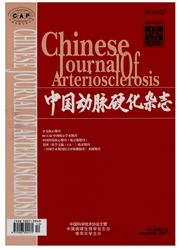

 中文摘要:
中文摘要:
目的:观察百草枯所致C57BL/6小鼠肺纤维化时肺组织酸性鞘磷脂酶(acid sphingomyelinase,ASM)的表达变化,初步探讨ASM在百草枯所致肺纤维化发生发展中的潜在病理意义。方法:将20只C57BL/6雄性小鼠随机分为对照组和百草枯组,百草枯组动物腹腔注射20 mg/kg百草枯,对照组动物注射等体积生理盐水,单次注射百草枯21 d后麻醉动物进行支气管肺泡灌洗,取支气管肺泡灌洗液(bronchial alveolar lavage fluid,BALF)检测灌洗液中细胞总数、总蛋白浓度,ELISA法检测BALF中IL-6和TNF-α水平;取肺组织,HE染色和Masson染色观察组织形态学变化和胶原沉积,TUNEL染色和Caspase-3活性检测细胞凋亡情况,DHE染色检测活性氧(reactive oxtgen species,ROS)水平,Real time PCR、免疫组织化学、Western Blot检测肺组织中ASM mRNA和蛋白表达。结果:用百草枯处理后,C57BL/6小鼠肺组织肺泡排列紊乱、部分肺泡出现塌陷、肺泡间隔增厚、炎性细胞浸润,肺组织中出现大量胶原沉积。与对照组相比,百草枯组小鼠BALF中细胞总数增多(P〈0.01),总蛋白浓度增加(P〈0.01),IL-6和TNF-α水平升高(P〈0.05);肺组织中TUNEL染色阳性细胞数增多(P〈0.01),Caspase-3活性增加(P〈0.05),ROS水平升高,ASM mRNA和蛋白表达上调(P〈0.05)。结论:ASM可能参与百草枯所致肺纤维化的病理生理过程,其具体作用机制有待进一步研究证实。
 英文摘要:
英文摘要:
AIM: To study the expression of acid sphingomyelinase (ASM) in lung tissues of pa- raquat-induced pulmonary fibrosis mice, and to ex- plore its potential pathological significance in the genesis and development of paraquat-induced fibro- sis. METHODS: Twenty C57BL/6 mice were ran- domly divided into two groups: normal control group and paraquat group. The mice of paraquat group were induced pulmonary fibrosis by a single injection of paraquat (20 mg/kg) intraperitonealy while the mice of normal control were given saline instead in the same condition. Twenty-one days after injection, total cell numbers, total protein concentration, and the level of IL-6 and TNF-ct in bronchial alveolar lavage fluid (BALF) were estimated. Histopatholog- ical changes and collagen deposition in the lungs were evaluated by HE staining and Masson assay. TUNEL assay and caspase-3 activity were used to detect the change of cell apoptosis in the lung tis- sues. The levels of reactive oxygen species (ROS) were measured by using dihydroethidium (DHE) staining. The mRNA expression of ASM was evalua- ted by Real time PCR analysis, and the immunohis- tochemical and Western Blot methods were used to measure the change of ASM protein. RESULTS: After treatment with paraquat, the lung tissues of C57BL/6 mice showed destruction of alveolar struc- ture, collapse of alveoli, thickness of alveolar septa, infiltration of inflammatory cells, and extensive col- lagen deposition. The total cells and total protein, the level of IL-6 and TNF-~x in BALF of paraquat- treated mice were significantly higher than that of normal control mice ( P 〈 0.05 ). Compared with normal control group, the ratio of cell apoptosis, caspase-3 activity and the level of ROS in lung tis- sues were obviously increased in the paraquat group. Meanwhile, the results of real time PCR, immuno- histochemistry and Western blot showed that the ex- pression of ASM mRNA and protein in lung tissues of paraquat-treated mice was up-regulated. CON- CLUSION: A
 同期刊论文项目
同期刊论文项目
 同项目期刊论文
同项目期刊论文
 期刊信息
期刊信息
